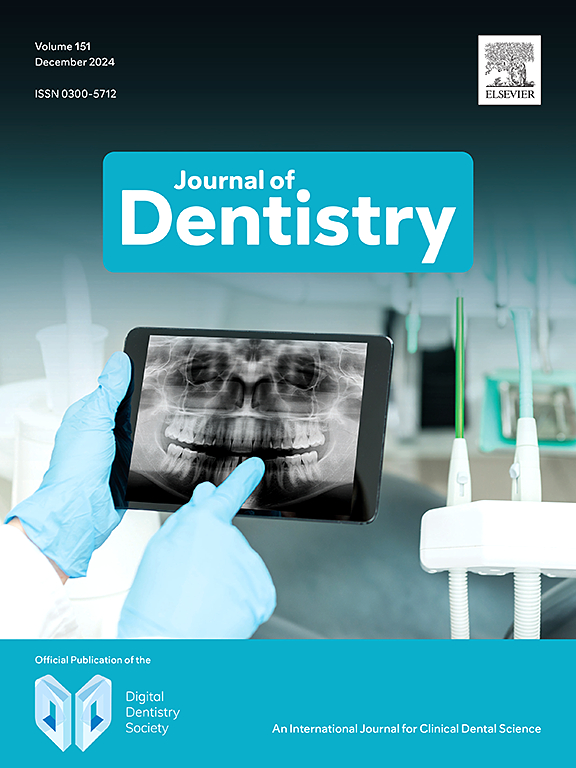根尖牙周炎伴鼻窦炎的微生物共感染相互作用网络。
IF 4.8
2区 医学
Q1 DENTISTRY, ORAL SURGERY & MEDICINE
引用次数: 0
摘要
目的:本研究旨在通过16S rRNA新一代测序(NGS)研究中国人群根尖牙周炎患者窦道存在的细菌共发生特征和潜在相互作用。方法:26例患者根管标本31份。提取细菌DNA后,对16S rRNA基因的V3-V4高变区进行测序。根据是否存在窦束进行成分多样性、突出类群和共现网络分析。结果:两组总体微生物群表现出不同的模式。在有鼻窦束的样品中,放线菌数量最多,而在无鼻窦束的样品中,普雷沃氏菌数量最多。窦道主要病原菌呈现出复杂的共发生网络,其中假单胞菌形成了一个独特的簇,丰度丰富,以Desulfovibrio和Pseudoramibacter为中心的广泛相关性可能提示新的依赖关系。在没有窦束的网络中,拟杆菌门和厚壁菌门类群之间存在密切的内部联系。结论:测序结果证实了AP中微生物群的复杂性。鼻窦束的存在与独特的感染模式和复杂的微生物共感染相互作用网络有关。应该采取进一步的研究来阐明新的相互作用与疾病进展之间的关系。临床意义:探讨微生物的相互作用有助于对根尖牙周炎的病因有更好的认识。利用下一代测序技术,我们的研究揭示了细菌群落结构,并观察到与窦道相关的共感染网络,为持续炎症的预后预测和靶向治疗提供了潜在的见解。本文章由计算机程序翻译,如有差异,请以英文原文为准。
The microbial co-infection interaction network in apical periodontitis with sinus tracts
Objectives
This study aims to characterize the bacterial co-occurrence features and potential interactions associated with the presence of sinus tracts in apical periodontitis in a Chinese population by using 16S rRNA next-generation sequencing (NGS).
Methods
Thirty-one samples from twenty-six patients were collected from root canals. Following the extraction of the bacterial DNA, the V3–V4 hypervariable regions of the 16S rRNA gene were sequenced. Compositional diversity, prominent taxa and co-occurrence network analysis were compared according to the presence or absence of sinus tracts.
Results
The overall microbiota in two groups exhibited distinguished patterns. Actinomyces dominated in samples with sinus tracts while Prevotella was the most abundant in samples without sinus tracts. The major pathogens in sinus tracts exhibited a complex co-occurrence network, in which Pseudomonas formed a distinctive cluster with enriched abundance, and the extensive correlations centered on Desulfovibrio and Pseudoramibacter may suggest novel dependencies. In the network without sinus tracts, the Bacteroidetes and Firmicutes taxa presented close internal associations.
Conclusions
The sequencing results confirmed the complexity of the microbiota in AP. The presence of sinus tracts was associated with distinctive infective patterns and complicated microbial co-infection interaction networks. Further investigations should be adopted to elucidate the relationship between the novel interactions and disease progression.
Clinical significance
Exploring the microbial interactions leads to a better understanding of etiology of apical periodontitis. Utilizing next generation sequencing techniques, our research uncovered the bacterial community structure and observed co-infection networks associated with sinus tracts, providing potential insights for prognosis prediction and targeted therapeutics of persistent inflammation.
求助全文
通过发布文献求助,成功后即可免费获取论文全文。
去求助
来源期刊

Journal of dentistry
医学-牙科与口腔外科
CiteScore
7.30
自引率
11.40%
发文量
349
审稿时长
35 days
期刊介绍:
The Journal of Dentistry has an open access mirror journal The Journal of Dentistry: X, sharing the same aims and scope, editorial team, submission system and rigorous peer review.
The Journal of Dentistry is the leading international dental journal within the field of Restorative Dentistry. Placing an emphasis on publishing novel and high-quality research papers, the Journal aims to influence the practice of dentistry at clinician, research, industry and policy-maker level on an international basis.
Topics covered include the management of dental disease, periodontology, endodontology, operative dentistry, fixed and removable prosthodontics, dental biomaterials science, long-term clinical trials including epidemiology and oral health, technology transfer of new scientific instrumentation or procedures, as well as clinically relevant oral biology and translational research.
The Journal of Dentistry will publish original scientific research papers including short communications. It is also interested in publishing review articles and leaders in themed areas which will be linked to new scientific research. Conference proceedings are also welcome and expressions of interest should be communicated to the Editor.
 求助内容:
求助内容: 应助结果提醒方式:
应助结果提醒方式:


